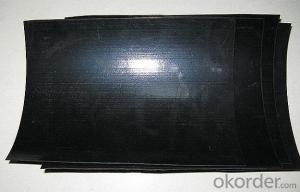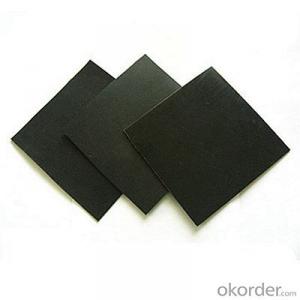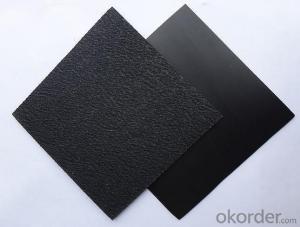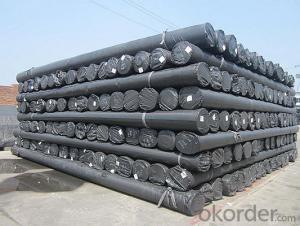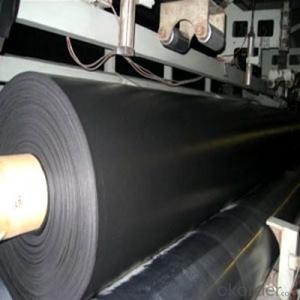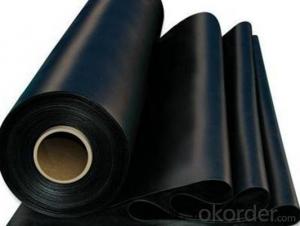Best Quality Linear Low-density Polyethylene Geomembrane
- Loading Port:
- China main port
- Payment Terms:
- TT OR LC
- Min Order Qty:
- 1000 m²
- Supply Capability:
- 1000000 m²/month
OKorder Service Pledge
OKorder Financial Service
You Might Also Like
Item specifice
Applications:
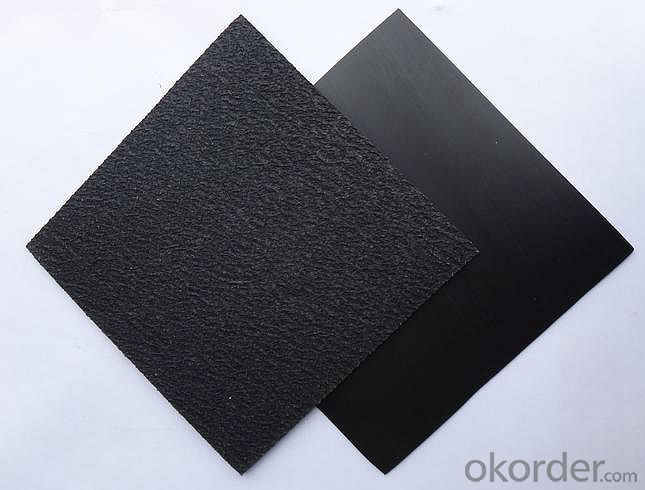
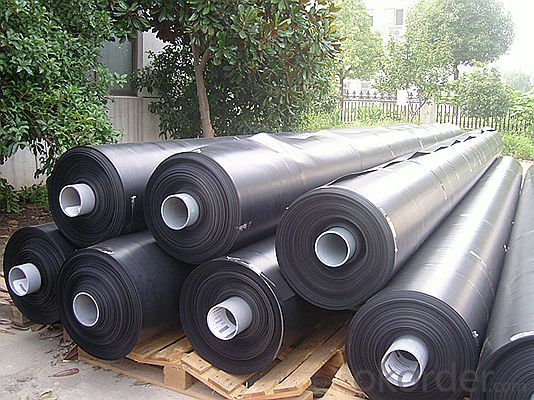
Flexible membranes are used in a variety of applications, such as:
Landfill lining
to protect the ground water from contamination.
Landfills capping
to prevent fluid flow in the landfill, to trap and properly vent the gases generated during decomposition of organic waste and to permit efficient revegetation and restoration of the area.
Water reservoirs
for collecting rain-water before it reaches the sea.
Reservoirs for waste-water
to protect the groundwater sources or streams.
Pond-lining
for artificial lakes and irrigation of farms.
Irrigation canals
an economic alternative to concrete and compacted earth for transporting water and irrigating large areas. Also used to reduce seepage from existing deteriorated concrete linings.
Protection of lake banks
for soil stabilization.
Tunnels
protecting the structure against humidity and water pressure.
Earth dams
for soil stabilization.
Underground insulation
of chemical plants, petrol stations & roads to prevent chemicals, oil etc. from polluting the underground water in case of a leakage.
Mining
for preventing contamination of the soil and underground water and permitting extraction of precious metals by heap leaching, using chemical solutions.
Tanks
secondary lining for preventing pollution in case of leakage or chemical spill.
Insulation of buildings & construction projects
Evaporation basins
Aquaculture
Water reservoirs for fish breeding.
Our Service
Quality assurance
1.On a regular basis or as per your request,we entrust national testing agencies to conduct quality inspections
2. Strictly in accordance with the ISO9001-2008 international quality system standard,we monitor and manage the whole process throughout production,quality testing,and measurement to ensure product quality
3. For quality-related construction delay or substandard construction(except for damage or losses due to customer’s responsibility or irresistible natural disasters),we have refunding,replacement,and repair services.We will respond to customers’ feedbacks on quality issues within 24 hours.
Packing: PLASTIC FILM INSIDE, AND WOVEN BAG OUTSIDE
Shipping: About 15 days after receipt the deposit
FAQ:
Q: What kind of payments does jenor support?
A: T/T, L/C, Cash are accepted.
Q: Do you charge for the samples?
A: Accordeing to our company policy, the samples are free, we only charge the freight fee. And we will return the freight fee during the next order.
Q: Can you produce according to customers' design?
A: Sure, we are professional manufacturer, OEM and ODM are both welcome.
Q: Do you have other products?
A: Yes, please check the pictures:
Packaging & Shipping
- Q:SNG400-3.5 geotextile is what model
- SNG400-3.5 refers to the national standard polyester staple acupuncture non-woven geotextile 400g / ㎡, width 3.5m. The index code for staple acupuncture nonwoven geotextiles is generally SNG / (1) (2) / (3) - (4) / (5). (1) that the use of raw materials fiber code: PET-polyester, PP-polypropylene, PA-nylon, PV-vinylon, PE-Ethylene (conventional polyester are generally vacant omitted code) (2) that polyester staple fiber non-woven Geotextile per unit area weight. (3) that the composite products in the polyester staple fiber non-woven geotextile weight per unit area, non-composite product vacancies. (4) width, expressed in meters (5) production department number: can express the product more specific characteristics, functions, varieties, sequences, etc., the general vacancy. For example, a 3.5m wide 400g / ㎡ polyester staple fiber nonwoven geotextile representation can be SNG / PET400-3.5, can also be expressed as SNG400-3.5
- Q:What are the advantages of using geotextiles in hydraulic applications?
- Geotextiles offer numerous advantages in hydraulic applications. Firstly, they provide effective filtration, allowing water to pass through while retaining fine particles and preventing clogging of drainage systems. Additionally, geotextiles enhance soil stability and prevent erosion by reinforcing the soil structure. They also aid in water drainage and control, reducing the risk of excess water buildup and potential damage to infrastructure. Geotextiles are easy to install and cost-effective, making them a practical choice for various hydraulic projects.
- Q:Can geotextiles be used in mining reclamation projects?
- Yes, geotextiles can be used in mining reclamation projects. Geotextiles are permeable fabrics that can be used to control erosion, stabilize slopes, and drain water in mining reclamation sites. They provide effective soil separation and filtration, preventing sedimentation and promoting vegetation growth, ultimately aiding in the restoration of the site's ecological balance.
- Q:How do geotextiles help in filtration of stormwater?
- Geotextiles help in the filtration of stormwater by acting as a barrier that allows water to pass through while trapping sediment, debris, and pollutants. They prevent these contaminants from entering the drainage system, improving water quality and reducing the risk of clogging in stormwater infrastructure. Additionally, geotextiles promote infiltration, allowing stormwater to percolate into the underlying soil, thus replenishing groundwater levels and reducing the chances of flooding.
- Q:What equipment is geotextile equipment?
- This I do not how clear, and detailed you can go to Long Yun machinery manufacturers to see, his home is specialized in producing this equipment manufacturers, hoping to help you to adopt.
- Q:Are geotextiles resistant to rodent penetration?
- Yes, geotextiles are generally resistant to rodent penetration. Their dense and tightly woven structure makes it difficult for rodents to burrow through or chew on the material.
- Q:How do geotextiles help with reinforcement of geotextile bags?
- Geotextiles help with the reinforcement of geotextile bags by providing strength and stability to the bags. They act as a barrier and prevent the soil or other fill material from escaping through the pores of the bags. Additionally, the geotextiles distribute the weight of the fill material evenly, reducing the risk of bulging or bursting of the bags.
- Q:what are Smart Geotextiles?
- These are textiles which use nano-technology to behave in certain ways under specific conditions. For example, a textile used for a tent can be white when the surrounding air is hot, but will turn black or dark when it's cold so it can absorb heat.
- Q:In the cofferdam construction process, geotextile materials after entering the need to arrange sampling test? Is there a specification? If the arrangements for testing, is to do physical experiments, or do chemical experiments, or do? More
- On the use of geotextile material, depending on whether the design requirements on the use of drawings, if required to use the method must be taken in the sampling inspection, the most commonly used two geotextiles GB / T-2008 is filament spunbond acupuncture Non-woven geotextile, GB / T-1998 is staple acupuncture non-woven geotextile, the general arrangements for testing are to do physical and mechanical properties (dynamic perforation, per unit area of quality, thickness, wide strip stretch, trapezoidal tear) other indicators Not mandatory
- Q:Are geotextiles resistant to punctures and tears?
- Yes, geotextiles are generally designed to be resistant to punctures and tears. They are made from strong materials that provide durability and can withstand external forces, making them an effective solution for various applications requiring such resistance.
1. Manufacturer Overview |
|
|---|---|
| Location | |
| Year Established | |
| Annual Output Value | |
| Main Markets | |
| Company Certifications | |
2. Manufacturer Certificates |
|
|---|---|
| a) Certification Name | |
| Range | |
| Reference | |
| Validity Period | |
3. Manufacturer Capability |
|
|---|---|
| a)Trade Capacity | |
| Nearest Port | |
| Export Percentage | |
| No.of Employees in Trade Department | |
| Language Spoken: | |
| b)Factory Information | |
| Factory Size: | |
| No. of Production Lines | |
| Contract Manufacturing | |
| Product Price Range | |
Send your message to us
Best Quality Linear Low-density Polyethylene Geomembrane
- Loading Port:
- China main port
- Payment Terms:
- TT OR LC
- Min Order Qty:
- 1000 m²
- Supply Capability:
- 1000000 m²/month
OKorder Service Pledge
OKorder Financial Service
Similar products
New products
Hot products
Related keywords
